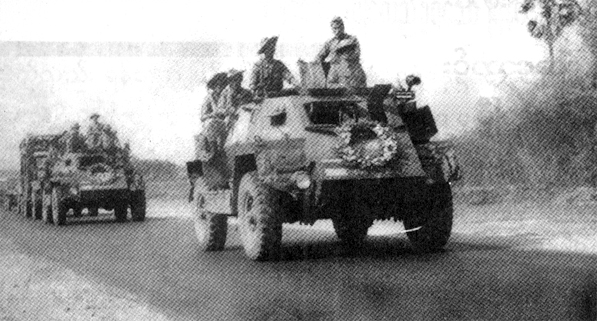Tun Tin saw tears in the eyes of Karen nurses, surprised at the unexpected offer of aid from a former adversary.
The Battle of Insein was over, but the Karens’ fight for equal rights continued—and lingers on.
Karen soldiers were pushed through the Irrawaddy delta and later to the Thai-Burmese border. In 1950, Saw Ba U Gyi and senior Karen leaders were killed at the Thai-Burmese border.
Tun Tin served as a “moderate force” in the Ne Win government, becoming deputy prime minister in the 1980s and frequently traveling abroad to seek development aid for Burma from the West.
He was briefly Prime Minister, but resigned at the time of the 1988 uprising. He lives quietly now in Rangoon, meditating and writing. A recent book describes his army experience and contains a description of the Battle of Insein.
Kyaw Zaw led a famous battle against invading Kuomintang forces in northern Burma but was sacked in 1957, accused of leaking information to the Communist Party of Burma (CPB). He and his family made clandestine journey to northern Burma and joined the CPB in 1976.
In his book, Kyaw Zaw admitted that he was a faithful party member of CPB and that he had long maintained a line of communication with the party.
Karen soldiers and civilians recently celebrated in the jungle on the Thai-Burmese border the 60th anniversary of the founding of the Karen National Union, whose aim of justice and peace in Burma remains a distant dream. The Battle of Insein never truly ended.
An ex-naval volunteer Wrote: |
16/02/2009 |
|
Thank you for this interesting article on the Battle of Insein. You may have inadvertently left out a very important event which occurred between February 9 to 13, 1949, which had a direct bearing on the outcome of the battle and perhaps changed the course of history. As a participant of this little-known, long-forgotten episode which I would like to name “The Ambush at Wetkaw,” may I add a few words of my own?
On February 1, 1949, Gen Ne Win took over from Karen Gen Smith Dun who went on leave. The Karens at Insein, believing that time was not on their side, and aware that the well experienced 5th Burma Rifles stationed in Arakan was being airlifted, asked their Second Karen Rifles, the best equipped battalion of our army at that time, stationed at Prome by the government, to rush down and help them at Insein.
This full-strength battalion of over 1,000 professional soldiers rushed down Prome highway in 120 vehicles, spearheaded by an armored carrier and supported by two six-pounder artillery pieces, eight three-inch mortars manned by Gurkha specialists, and with enough ammunition for a brigade to help and rescue their besieged brothers at Insein. They reached Zigon on February 8.
At that time, Brig Kyaw Zaw had not taken charge of our forces. There were no regular government troops to stand up against this elite, battle-hardened Karen battalion. Our only regular troops nearest to Yangon [Rangoon] was the 3rd Burma Rifles, which were stationed at Maubin, Pyapon and Dedaye. And, I should say, half a battalion strength was left, commanded by then Major Chit Myaing as the new Commanding Officer, after the [former] CO, Colonel Ye Htut, had gone underground with half his men to join the Communists.
As Twante Canal was in the hands of the KNDO, ready to block any government troops attempting to transit the canal, the half-strength 3rd Burma Rifles Battalion had to be lifted overnight by inland double-decker steamers via the unused river and sea passage at great risk on February 5, 1949. The battalion consisted of four under-strength infantry companies and was equipped with only four three-inch mortars. A six-pounder scratch gun crew of UTC lads and a volunteer Naval Bofors gun crew which had been supporting our forces at Insein, were hastily organized to provide artillery support.
When this makeshift government force arrived at Gyobingauk on Feb 9, the bridge at Wetkaw, a few miles south of Zigon, had already been abandoned by government Levies and armed UMPs. In the early morning of Feb 10, the mechanized Force of the Second Karen Rifles crossed Wetkaw bridge at leisure and commenced to make a dash for Yangon, fully confident that there were no government forces or Guns strong enough to oppose them all the way to Insein, and felt quite invincible.
Fortunately for the government, the element of surprise was with the government forces. The Naval Bofors gun mounted on wheels, which is capable of firing 40-mm shells at 120 rounds/minute, stood on the road in their way and opened fire point-blank at 500 yards, knocking out their armored carrier and also damaging one of the six-pounder guns. This action was totally unexpected by the Karen Forces who neglected to position a scouting patrol in front.
For next two days there were attacks and counter-attacks, and exchanges of mortar fire between the two forces, until the naval Bofors found a clear position to directly shell the insurgent vehicles, which demoralized them completely.
On Feb 13, the Karen Forces with their families abandoned all their vehicles and heavy equipment and attempted to escape towards the Pegu Yomas. Both second-in-command and the CO were captured however. In the recently written words of a historian of the Karen struggle “... thus came the end of the very first and perhaps, most important phase of the Karen struggle.”
Anyone who is reading this may ponder what would have happened in the course of history if the “Ambush at Wetkaw” had not taken place on Feb 10, 1949. I myself could not help thinking yesterday when I visited the Bridge at Wetkaw and the site of this action on the 60th anniversary to pay homage to the comrades –in-arms of both forces who are no longer with us.
|
|
 |

